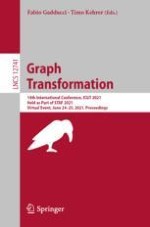2021 | Buch
Graph Transformation
14th International Conference, ICGT 2021, Held as Part of STAF 2021, Virtual Event, June 24–25, 2021, Proceedings
herausgegeben von: Prof. Fabio Gadducci, Timo Kehrer
Verlag: Springer International Publishing
Buchreihe : Lecture Notes in Computer Science

 of Graph Conditions (GCs). The
of Graph Conditions (GCs). The  is as expressive as first-order logic on graphs and infinitely many graphs may be evaluated against a given GC. Therefore, a complete compact overview of
is as expressive as first-order logic on graphs and infinitely many graphs may be evaluated against a given GC. Therefore, a complete compact overview of  to a running example.
to a running example.